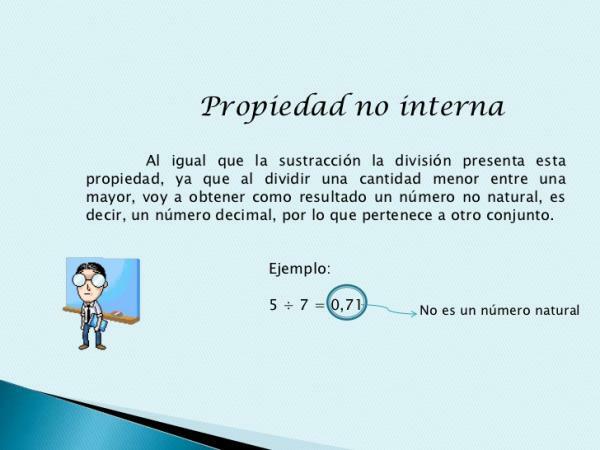Division properties

In this new lesson from a TEACHER we address the topic of division properties. As usual, we will start from a theoretical context that is explained in the video, of each of these properties, where the we will explain in detail and we will present examples for each of them. The properties of the division that we consider important are: the fundamental property (exact and inexact), non-internal operation, non-commutative property, the neutral element and the zero. The lesson begins!
Index
- Summary of Division Properties
- The fundamental property
- Non-internal operation
- Non-commutative property
- Neutral element of division: 1
- The zero in the division
Summary of the properties of the division.
Here we offer you a summary about the division properties. They are as follows.
- Fundamental property of division: if the division is exact, the dividend is equal to the divisor times the quotient. On the other hand, if the division is inaccurate, the dividend will be equal to the divisor times the quotient plus the remainder.
- Non-internal operation: division is not an internal operation on the set of integers. The division of two natural numbers does not have to give another natural number. In other words, dividing two whole numbers may not result in another whole number. Also a characteristic of the division property is that it can never be divided by the number 0.
- Non-commutative property: the order of the elements of the SI division influences the result of this division. Unlike the addition and multiplication of numbers that do have the commutative property, subtraction and division are not commutative operations.
- Neutral element: the 1 is the neutral element of the division.
- The zero: zero divided by any number gives zero. Also, no number can be divided by zero.
You will understand all these properties much better with the video, since they are explained with examples. Before we refresh you some concepts of division so that you better understand what the properties of division are.
The fundamental property.
This property can be of two types:
- Exact: if the remainder is zero (0). That is, when the Dividend is equal to the divisor times the quotient. It would be represented like this: D = d x c (D = dividend; d = divisor; c = quotient)
- Inaccurate: when the remainder is a number other than zero.
It is represented like this: D = d x c + r (where r = remainder)

Image: Studylib
Non-internal operation.
Another property of division is that it is a non-internal operation. This means that when we divide a natural number by another natural number, not always the result of this operation will be a Natural number. Because it can also be the case that the division results in a decimal number (whether the dividend is smaller than the divisor, as well as if the dividend is greater than the divisor)
For example: 2/4 = 0.5
This happens when the dividend is smaller what andl divider. We note that the result is decimal less than zero.
Example 2: 3/2 = 1.5
This happens when the dividend is greater than the divisor. We observe that the result is a decimal greater than zero.

Image: Slideshare
Non-commutative property.
As a review, it is pertinent to remember that the commutative property indicates that The order of the factors does not alter the product, in the case of addition and multiplication.
Within the division it does alter it, since it is not the same that the dividend is greater than the divisor and vice versa; the result will be completely different if we alter that order. For this reason, division has a non-commutative property.
For example: 8/2 = 4 is not the same; that 2/8 = 0.25. The result is totally different, because they are different operations.
Neutral element of division: 1.
The neutral element of the division is the number 1. This means that any number divided by 1 will result in the same number. In this sense, we can affirm that the same logic is used as in multiplication, since when multiplying a number by 1, the result will always be the number to which you are multiplying 1 (Example: 5 x 1 = 5)
The same thing happens in division. For example: 8/1 = 8. The result of the operation will be the same number corresponding to the dividend (provided that the divisor is 1).

Image: Slideshare
The zero in the division.
We end this review of the revision properties by talking about zero. For this property you have to take into account two elements that we consider essential to understand it:
- The number zero (0) divided by any number, it will have as zero result (0). Similar to multiplication, where any number multiplied by zero results in zero (0). Well, in the case of division we apply the same logic. For example: 0/7 = 0.
- On the other hand, another element to take into account in the division is that cannot be divided by zero, since there is no number multiplied by zero that is different than zero (0). Likewise, we can explain it by saying that the division represents a distribution and if it is divided any number between zero, since there is no such distribution because there is no division.
If you want to read more articles similar to Division properties, we recommend that you enter our category of Basic operations.

